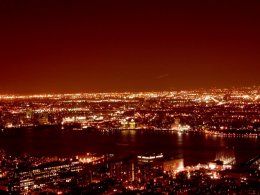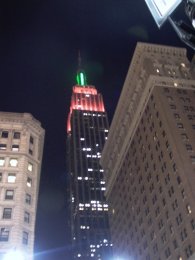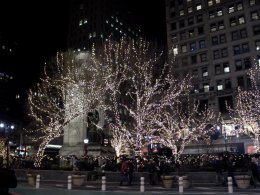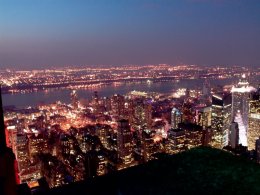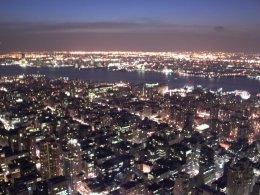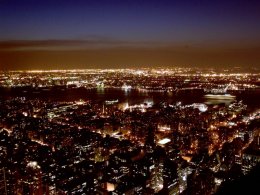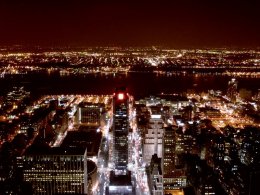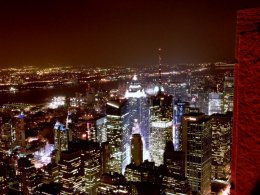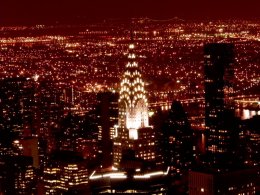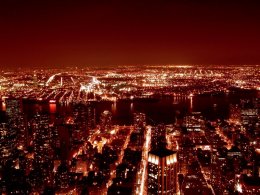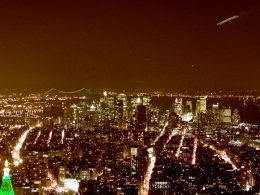摘錄美國最高法院一則判例~~work made for hire
by 羅鎮 2011-07-14 12:21:18, 回應(2), 人氣(3944)
2011-07-14 12:21:18, 回應(2), 人氣(3944)
原文如下:
COMMUNITY FOR CREATIVE NON-VIOLENCE ET AL. v. REID
In this case, an artist and the organization that hired him to produce a sculpture contest the ownership of the copyright in that work. To resolve this dispute, we must construe the "work made for hire" provisions of the Copyright Act of 1976 (Act or 1976 Act), 17 U. S. C. §§101 and 201(b), and
in particular, the provision in §101, which defines as a "work made for hire" a "work prepared by an
employee within the scope of his or her employment" (hereinafter §101(1)).
in particular, the provision in §101, which defines as a "work made for hire" a "work prepared by an
employee within the scope of his or her employment" (hereinafter §101(1)).
Petitioners are the Community for Creative Non-Violence (CCNV), a nonprofit unincorporated
association dedicated to eliminating homelessness in America, and Mitch Snyder, a member and
trustee of CCNV. In the fall of 1985, CCNV decided to participate in the annual Christmastime
Pageant of Peace in Washington, D. C., by sponsoring a display to dramatize the plight of the homeless.
As the District Court recounted:
"Snyder and fellow CCNV members conceived the idea for the nature of the display:
a sculpture of a modern Nativity scene in which, in lieu of the traditional Holy Family,
the two adult figures and the infant would appear as contemporary homeless people
huddled on a streetside steam grate. The family was to be black (most of the homeless
in Washington being black); the figures were to be life-sized, and the steam grate
would be positioned atop a platform 'pedestal,' or base, within which special-effects
equipment would be enclosed to emit simulated 'steam' through the grid to swirl about
the figures. They also settled upon a title for the work -- 'Third World America' -- and
a legend for the pedestal: 'and still there is no room at the inn.'"
Snyder made inquiries to locate an artist to produce the sculpture. He was referred to respondent
James Earl Reid, a Baltimore, Maryland, sculptor. In the course of two telephone calls, Reid agreed
to sculpt the three human figures. CCNV agreed to make the steam grate and pedestal for the
statue. Reid proposed that the work be cast in bronze, at a total cost of approximately $ 100,000 and
taking six to eight months to complete. Snyder rejected that proposal because CCNV did not have
sufficient funds, and because the statue had to be completed by December 12 to be included in the
pageant. Reid then suggested, and Snyder agreed, that the sculpture would be made of a material
known as "Design Cast 62," a synthetic substance that could meet CCNV's monetary and time constraints,
could be tinted to resemble bronze, and could withstand the elements. The parties agreed
that the project would cost no more than $ 15,000, not including Reid's services, which he offered to
donate. The parties did not sign a written agreement. Neither party mentioned copyright.
After Reid received an advance of $ 3,000, he made several sketches of figures in various poses.
At Snyder's request, Reid sent CCNV a sketch of a proposed sculpture showing the family in a
crechelike setting: the mother seated, cradling a baby in her lap; the father standing behind her,
bending over her shoulder to touch the baby's foot. Reid testified that Snyder asked for the sketch
to use in raising funds for the sculpture. Snyder testified that it was also for his approval. Reid
sought a black family to serve as a model for the sculpture. Upon Snyder's suggestion, Reid visiteda family living at CCNV's Washington shelter but decided that only their newly born child was a
suitable model. While Reid was in Washington, Snyder took him to see homeless people living on
the streets. Snyder pointed out that they tended to recline on steam grates, rather than sit or stand,
in order to warm their bodies. From that time on, Reid's sketches contained only reclining figures.
Throughout November and the first two weeks of December 1985, Reid worked exclusively on
the statue, assisted at various times by a dozen different people who were paid with funds provided
in installments by CCNV. On a number of occasions, CCNV members visited Reid to check on his
progress and to coordinate CCNV's construction of the base. CCNV rejected Reid's proposal to use
suitcases or shopping bags to hold the family's personal belongings, insisting instead on a shopping
cart. Reid and CCNV members did not discuss copyright ownership on any of these visits.
On December 24, 1985, 12 days after the agreed-upon date, Reid delivered the completed
statue to Washington. There it was joined to the steam grate and pedestal prepared by CCNV and
placed on display near the site of the pageant. Snyder paid Reid the final installment of the
$15,000. The statue remained on display for a month. In late January 1986, CCNV members returned
it to Reid's studio in Baltimore for minor repairs. Several weeks later, Snyder began making
plans to take the statue on a tour of several cities to raise money for the homeless. Reid objected,
contending that the Design Cast 62 material was not strong enough to withstand the ambitious itinerary.
He urged CCNV to cast the statue in bronze at a cost of $ 35,000, or to create a master mold
at a cost of $ 5,000. Snyder declined to spend more of CCNV's money on the project.
In March 1986, Snyder asked Reid to return the sculpture. Reid refused. He then filed a certificate
of copyright registration for "Third World America" in his name and announced plans to take
the sculpture on a more modest tour than the one CCNV had proposed. Snyder, acting in his capacity
as CCNV's trustee, immediately filed a competing certificate of copyright registration.
Snyder and CCNV then commenced this action against Reid and his photographer, Ronald Purtee,
1 seeking return of the sculpture and a determination of copyright ownership. The District Court
granted a preliminary injunction, ordering the sculpture's return. After a 2-day bench trial, the District
Court declared that "Third World America" was a "work made for hire" under §101 of the
Copyright Act and that Snyder, as trustee for CCNV, was the exclusive owner of the copyright in
the sculpture. The court reasoned that Reid had been an "employee" of CCNV within the meaning
of §101(1) because CCNV was the motivating force in the statue's production. Snyder and other
CCNV members, the court explained, "conceived the idea of a contemporary Nativity scene to contrast
with the national celebration of the season," and "directed enough of [Reid's] effort to assure
that, in the end, he had produced what they, not he, wanted."
association dedicated to eliminating homelessness in America, and Mitch Snyder, a member and
trustee of CCNV. In the fall of 1985, CCNV decided to participate in the annual Christmastime
Pageant of Peace in Washington, D. C., by sponsoring a display to dramatize the plight of the homeless.
As the District Court recounted:
"Snyder and fellow CCNV members conceived the idea for the nature of the display:
a sculpture of a modern Nativity scene in which, in lieu of the traditional Holy Family,
the two adult figures and the infant would appear as contemporary homeless people
huddled on a streetside steam grate. The family was to be black (most of the homeless
in Washington being black); the figures were to be life-sized, and the steam grate
would be positioned atop a platform 'pedestal,' or base, within which special-effects
equipment would be enclosed to emit simulated 'steam' through the grid to swirl about
the figures. They also settled upon a title for the work -- 'Third World America' -- and
a legend for the pedestal: 'and still there is no room at the inn.'"
Snyder made inquiries to locate an artist to produce the sculpture. He was referred to respondent
James Earl Reid, a Baltimore, Maryland, sculptor. In the course of two telephone calls, Reid agreed
to sculpt the three human figures. CCNV agreed to make the steam grate and pedestal for the
statue. Reid proposed that the work be cast in bronze, at a total cost of approximately $ 100,000 and
taking six to eight months to complete. Snyder rejected that proposal because CCNV did not have
sufficient funds, and because the statue had to be completed by December 12 to be included in the
pageant. Reid then suggested, and Snyder agreed, that the sculpture would be made of a material
known as "Design Cast 62," a synthetic substance that could meet CCNV's monetary and time constraints,
could be tinted to resemble bronze, and could withstand the elements. The parties agreed
that the project would cost no more than $ 15,000, not including Reid's services, which he offered to
donate. The parties did not sign a written agreement. Neither party mentioned copyright.
After Reid received an advance of $ 3,000, he made several sketches of figures in various poses.
At Snyder's request, Reid sent CCNV a sketch of a proposed sculpture showing the family in a
crechelike setting: the mother seated, cradling a baby in her lap; the father standing behind her,
bending over her shoulder to touch the baby's foot. Reid testified that Snyder asked for the sketch
to use in raising funds for the sculpture. Snyder testified that it was also for his approval. Reid
sought a black family to serve as a model for the sculpture. Upon Snyder's suggestion, Reid visiteda family living at CCNV's Washington shelter but decided that only their newly born child was a
suitable model. While Reid was in Washington, Snyder took him to see homeless people living on
the streets. Snyder pointed out that they tended to recline on steam grates, rather than sit or stand,
in order to warm their bodies. From that time on, Reid's sketches contained only reclining figures.
Throughout November and the first two weeks of December 1985, Reid worked exclusively on
the statue, assisted at various times by a dozen different people who were paid with funds provided
in installments by CCNV. On a number of occasions, CCNV members visited Reid to check on his
progress and to coordinate CCNV's construction of the base. CCNV rejected Reid's proposal to use
suitcases or shopping bags to hold the family's personal belongings, insisting instead on a shopping
cart. Reid and CCNV members did not discuss copyright ownership on any of these visits.
On December 24, 1985, 12 days after the agreed-upon date, Reid delivered the completed
statue to Washington. There it was joined to the steam grate and pedestal prepared by CCNV and
placed on display near the site of the pageant. Snyder paid Reid the final installment of the
$15,000. The statue remained on display for a month. In late January 1986, CCNV members returned
it to Reid's studio in Baltimore for minor repairs. Several weeks later, Snyder began making
plans to take the statue on a tour of several cities to raise money for the homeless. Reid objected,
contending that the Design Cast 62 material was not strong enough to withstand the ambitious itinerary.
He urged CCNV to cast the statue in bronze at a cost of $ 35,000, or to create a master mold
at a cost of $ 5,000. Snyder declined to spend more of CCNV's money on the project.
In March 1986, Snyder asked Reid to return the sculpture. Reid refused. He then filed a certificate
of copyright registration for "Third World America" in his name and announced plans to take
the sculpture on a more modest tour than the one CCNV had proposed. Snyder, acting in his capacity
as CCNV's trustee, immediately filed a competing certificate of copyright registration.
Snyder and CCNV then commenced this action against Reid and his photographer, Ronald Purtee,
1 seeking return of the sculpture and a determination of copyright ownership. The District Court
granted a preliminary injunction, ordering the sculpture's return. After a 2-day bench trial, the District
Court declared that "Third World America" was a "work made for hire" under §101 of the
Copyright Act and that Snyder, as trustee for CCNV, was the exclusive owner of the copyright in
the sculpture. The court reasoned that Reid had been an "employee" of CCNV within the meaning
of §101(1) because CCNV was the motivating force in the statue's production. Snyder and other
CCNV members, the court explained, "conceived the idea of a contemporary Nativity scene to contrast
with the national celebration of the season," and "directed enough of [Reid's] effort to assure
that, in the end, he had produced what they, not he, wanted."
The Court of Appeals for the District of Columbia Circuit reversed and remanded, holding that
Reid owned the copyright because "Third World America" was not a work for hire. Adopting what
it termed the "literal interpretation" of the Act as articulated by the Fifth Circuit in Easter Seal Society
for Crippled Children & Adults of Louisiana, Inc. v. Playboy Enterprises, 815 F. 2d 323, 329
(1987), cert. denied, 485 U.S. 981 (1988), the court read §101 as creating "a simple dichotomy in
fact between employees and independent contractors." Because, under agency law, Reid was an
independent contractor, the court concluded that the work was not "prepared by an employee" under
§101(1). Nor was the sculpture a "work made for hire" under the second subsection of §101 (hereinafter
§101(2)): sculpture is not one of the nine categories of works enumerated in that subsection,and the parties had not agreed in writing that the sculpture would be a work for hire. The court suggested
that the sculpture nevertheless may have been jointly authored by CCNV and Reid, and remanded
for a determination whether the sculpture is indeed a joint work under the Act.
We granted certiorari to resolve a conflict among the Courts of Appeals over the proper construction
of the "work made for hire" provisions of the Act.2 We now affirm.
Reid owned the copyright because "Third World America" was not a work for hire. Adopting what
it termed the "literal interpretation" of the Act as articulated by the Fifth Circuit in Easter Seal Society
for Crippled Children & Adults of Louisiana, Inc. v. Playboy Enterprises, 815 F. 2d 323, 329
(1987), cert. denied, 485 U.S. 981 (1988), the court read §101 as creating "a simple dichotomy in
fact between employees and independent contractors." Because, under agency law, Reid was an
independent contractor, the court concluded that the work was not "prepared by an employee" under
§101(1). Nor was the sculpture a "work made for hire" under the second subsection of §101 (hereinafter
§101(2)): sculpture is not one of the nine categories of works enumerated in that subsection,and the parties had not agreed in writing that the sculpture would be a work for hire. The court suggested
that the sculpture nevertheless may have been jointly authored by CCNV and Reid, and remanded
for a determination whether the sculpture is indeed a joint work under the Act.
We granted certiorari to resolve a conflict among the Courts of Appeals over the proper construction
of the "work made for hire" provisions of the Act.2 We now affirm.
附件:

